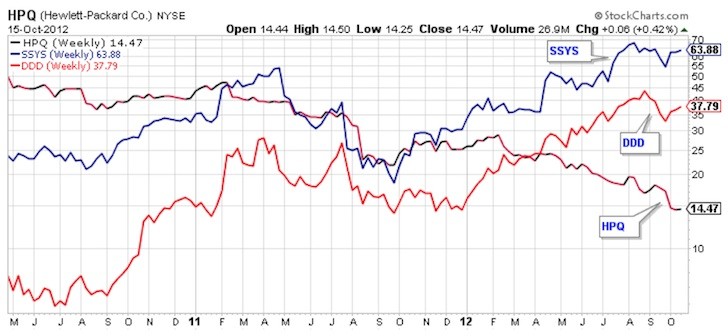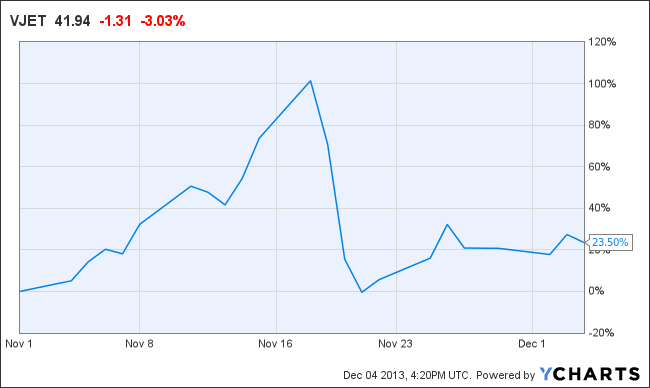How to Invest in 3D Printing Stocks for the Long Term (DDD SSYS)
Post on: 6 Июнь, 2015 No Comment

The overnight sensation that took 30 years. — James Woodcock, group editor of TCT Magazine + Personalize, a leading 3-D printing publication
This quote basically sums up the 3-D printing industry, having gone from a sleepy industrial prototyping process to a revolutionary technology that offers the potential to fundamentally change how the world manufactures everything and anything. Consequently, leading 3-D printing stocks like 3D Systems ( NYSE: DDD ) and Stratasys ( NASDAQ: SSYS ) have experienced tremendous volatility over the last few years as the media frenzy ensued.
Instead of trying to time what the 3-D printing sector is going to do next, which is nearly impossible to do consistently, investors are likely better off taking a long view and enduring the inevitable ups and downs that come along with investing in a richly valued, high-growth sector like 3-D printing. In other words, investing in 3D Systems, Stratasys, and other 3-D printing stocks is only for investors who can endure extreme fits of volatility for prolonged periods.
One of the biggest risks facing 3D Systems, Stratasys, and other 3-D printing stocks is the fact that the industry is currently undergoing rapid changes. A new technology or a patent could expire and completely disrupt entire businesses. 3D Systems is currently dealing with the threat of recent patents expiring around its stereolithography technology, which has been a mainstay in its higher-end portfolio for nearly three decades. With stereolithography now off patent protection, a number of start-ups are introducing significantly cheaper machines with near-identical technology that 3D Systems has historically reserved for its printers costing well into the high five-figure range.
The moral of the story? Diversification is essential.
Buying a basket of 3-D printing stocks is likely going to prove to be a more prudent strategy than just investing in one 3-D printing stock, because the future is uncertain as to which company will ultimately emerge a leader. Although it’s counter-intuitive that an industry that’s been around for over 30 years can still be emerging, adoption rates and industry size suggest that the 3-D printing growth story is still very much within its early stages. In 2013, the 3-D printing industry was estimated to be worth almost $3.1 billion, and is expected to be worth $10.8 billion by the close of 2021. Compared to traditional manufacturing, which represents trillions of dollars of GDP output each year, the 3-D printing industry is peanuts .
Forming a game plan
Investors looking to get involved with 3-D printing should consider the following:

- Start with the leaders. 3D Systems and Stratasys are currently the largest, most established, and most diversified businesses for investors to get exposure to rise of 3-D printing. Both companies have long track records of proven success, giving investors a higher degree of confidence in their long-term staying power. Investors looking to specialize more and gain exposure to specific 3-D printing segments, like 3-D metal printing, should examine companies like ExOne and Swedish-based Arcam. while being cognizant of the added risks associated of being too specialized.
- Set a long time horizon. Because 3D Systems, Stratasys, and other 3-D printing stocks are richly valued on paper, it’s best to set a longer term time horizon — preferably at least five years — to allow companies ample time to grow into their valuations and deliver on their promises. Doing so will also help mitigate the risk of short-term volatility.
- Understand allocation. Buying a basket of 3-D printing stocks doesn’t mean to take 100% of your portfolio and split it between four or five 3-D printing stocks. Make sure your total allocation doesn’t exceed more than a relatively small percentage of your overall portfolio. Consult with a financial professional to determine the appropriate allocation specific to your situation.
- Dollar-cost average. Because 3-D printing stocks can be extremely volatile, it’s wise to invest in the sector over time to average out your cost basis. Taking advantage of significant price declines may prove to be a great long-term strategy, as long as the underlying business fundamentals haven’t deteriorated along with a short-term stock price decline.
- Monitor material changes. Regularly check up on your investments to ensure any material developments haven’t changed your original investment thesis, and also make sure you understand the biases that make us bad investors .
- Take the emotion out. Although this is extremely difficult to do, with the right allocation, a risk-tolerant investor should be able to stomach the wild ups and downs that are sure to come with investing in 3-D printing stocks over the long term. Year-to-date, 3D Systems and Stratasys are underperforming the S&P 500 by more than 30%, which isn’t an easy pill to swallow. Adjust your position size accordingly to sleep easily.
In the following video, 3-D printing specialist Steve Heller and Industrials analyst Blake Bos break down how they approach investing in a high-growth sector like 3-D printing.
One must-own stock
Give me five minutes, and I’ll show how you could own the best stock for 2014. Every year, The Motley Fool’s chief investment officer hand-picks one stock with outstanding potential. But it’s not just any run-of-the-mill company. It’s a stock perfectly positioned to cash in on one of the upcoming year’s most lucrative trends. Last year, his pick skyrocketed 134%. And previous top picks have gained upwards of 908%, 1,252%, and 1,303% over the subsequent years! Believe me, you don’t want to miss what could be his biggest winner yet! Just click here to download your free copy of The Motley Fool’s Top Stock for 2014 today.














